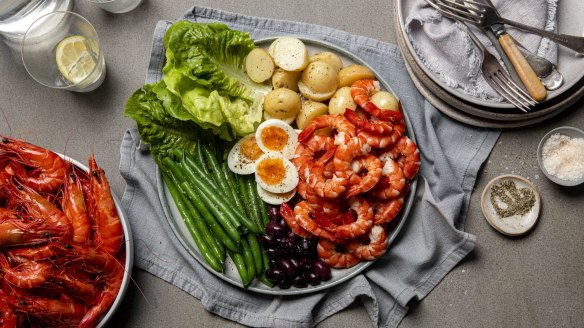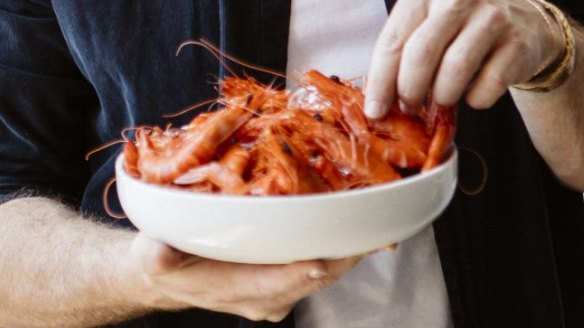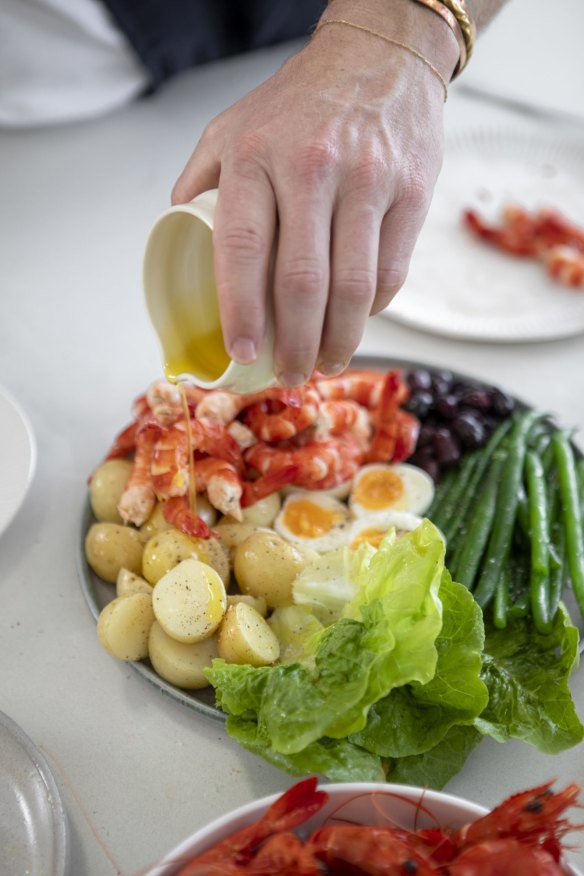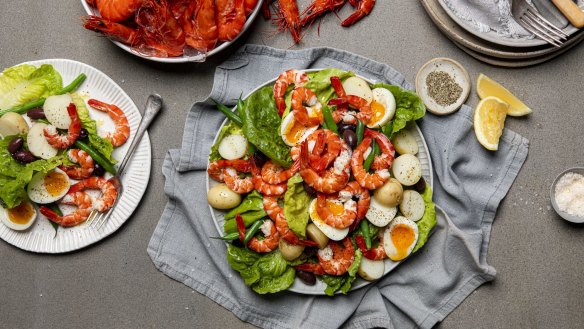Hayden Quinn's essential tips for making the most of prawns

- Hayden Quinn's two-step prawn nicoise salad recipe
- Recipe collection: 20 new ways to throw some prawns on the barbecue
If there's one common misconception about prawns, it's that they're fancy foods we should reserve for special occasions and feasts, says Hayden Quinn.
The Sydney cook, marine biologist and TV presenter believes the beauty of prawns is in their versatility – they're just as perfect for everyday eating as they are for celebratory cooking.

"It doesn't need to be Christmas to pull out a big bag of prawns and just dive straight in," says Quinn, who is also an ambassador for Tropic Co.
"You can eat them straight up, or there's lots of different things you can do to make the prawn really dance, whether it's on the plate or in your hands."
For many Australians, prawns capture the essence of simple seaside holidays with friends and family, Quinn says. They're tactile, fresh and colourful, plus healthy and loaded with zinc and vitamins B and E, unlike other popular "hand foods" such as sausage rolls and meat pies.
It doesn't need to be Christmas to pull out a big bag of prawns and just dive straight in.Hayden Quinn
Some of Quinn's favourite memories include sitting on the wharf at the fish markets with his grandfather, ripping off the shells and dunking prawns into Thousand Island sauce, and enjoying a prawn and avocado roll after a big day at the beach.
"That reminds me of [being] a little kid growing up when we'd go on holidays at Shoal Bay," he says. "We'd get the soft white roll with the dusting of flour on the top and smoosh in some avocado and pile on the prawns and a lot of pepper."
Delicious ways to eat prawns

One of the best ways to cook green prawns is barbecuing, thanks to the char and flame of the grill, Quinn says.
"That's one of my favourite [ways to eat prawns] – surrounded by friends, with a cold beer or glass of white wine or something bubbly – and then a great home-made dipping sauce and away you go."
For something a bit more advanced, a light and fragrant curry is a great vehicle for prawns, or try dressing up your omelette with a few crustaceans.
Prawns also work well with carbohydrates such as rice, pasta or potatoes in risottos, frittatas and salads. Try swapping chicken for prawns in a creamy Caesar salad, for example, or making a prawn nicoise salad.
Whether hot or cold, prawns are also the perfect partner for sauces – creamy cocktail styles, or sweet-salty-spicy Asian-style sauces such as nuoc cham.
"Think about rice noodles with prawns, avocado and fresh herbs in a rice paper roll, dipped into a really fragrant and zesty dipping sauce," he says.
Cooking hints and tricks
Overcooking is one of the biggest mistakes Quinn sees people make with green prawns. Like most seafood, quality prawns can be eaten raw or close to it, so it pays not to overheat the flesh.
If you're barbecuing raw prawns, make sure the cooking surface is super hot, then touch the prawn against the grill on each side just long enough to achieve a bit of colour and char, before pulling it quickly off the heat.
In terms of cooked prawns, it's always a "sad moment" when someone doesn't peel correctly, losing half the tail when they pull the shell off.
To peel a prawn properly, Quinn suggests removing the head first with your hands or a knife, then running your fingers under the legs and around the body, and down to the tail.
"Give it a gentle pinch and pull and you should be done," he says.
Remove the vein if you wish, but try not to damage the flesh while doing so – either by removing the head and pulling the vein out from that end or by inserting a skewer just above the tail and flicking the flesh up.
Choosing the right prawn
To pick a quality prawn, look for crustaceans without tell-tale discolouration or darkening around the head or legs, which can indicate the prawn hasn't been kept very well. Check the head, tail and eyes are still intact, and the antennae nice and long. For cooked prawns, the colour should be bright and vibrant.
Australian-raised or -caught prawns will always be your best bet, but in terms of size and variety, that depends on your preferences and how you intend to use them.
Medium-sized tiger prawns are good all-rounders for most dishes and large king prawns are perennial crowd-pleasers, but school prawns are great for deep-frying whole and serving with mayonnaise.
How to cook prawns
Before barbecuing, Quinn often removes the middle shell while retaining the head and tail – the partial shell improves flavour, helping the flesh steam and cook in its own juices, and can be quickly removed before eating.
If you're cooking over coals, he also suggests orientating the thickest and largest part of the prawn – the head – towards the hottest part of the barbecue to reduce the risk of overcooking.
Removing the shell before cooking is more important for banana prawns, which tend to have a thinner shell that can constrict with heat, making them particularly difficult to peel on the plate.
Defrost with care
Defrosting the right way is also key: never run frozen prawns under warm or hot water, for example. Leaving overnight in the fridge is best, even better if you keep them in an icy salt slurry before serving – that will firm up the flesh and reduce the risk of oxidisation and discolouration.
Once your prawn feast is over, don't waste those shells either. If you really love prawns, try making your own prawn oil by very gently cooking down the shells with some aromatics in quality extra virgin olive oil until all the water evaporates from the shell and the oil is a rich shade of deep orange-red.
"That is the essence of a prawn," Quinn says. "If you take that and you cook some angel hair pasta in a little bit of olive oil, garlic and chilli, and you drizzle prawn oil over that with some fresh prawns, frozen peas and emulsify that with the pasta water, I promise that is going to be one of the most delicious and simple prawn recipes you'll have and it's packed with flavour."

Hayden Quinn's prawn nicoise salad
An Australian spin on a classic using cooked tiger prawns. The colour, the texture and the vibrant flavours of this salad really make it a winner. Perfect for sharing whenever the friends come around, or a new family favourite any time of the week. Mix it up with your favourite additions or stick to the steps below.
INGREDIENTS
- 600g whole cooked tiger prawns, peeled, tails on
- 500g chat potatoes, halved
- 1 head butter lettuce, leaves separated
- 4 eggs, semi hard-boiled, peeled and halved
- 200g green beans, blanched
- ¾ cup pitted kalamata olives
- extra virgin olive oil, to serve
- lemon, to serve
- salt and pepper, to taste
- chopped dill and chives, to serve
METHOD
- Start the potatoes in a pot of cold salted water bringing to a gentle boil over medium-high heat, cooking until just tender. Drain and cool completely. Drizzle potatoes with a little olive oil and toss.
- Arrange prawns, potatoes, lettuce, eggs, beans, olives on a large serving dish. Drizzle with olive oil and a squeeze of lemon. Season with salt and pepper and top with dill and chives. Serve right away.
Recipe: Tropic Co.
